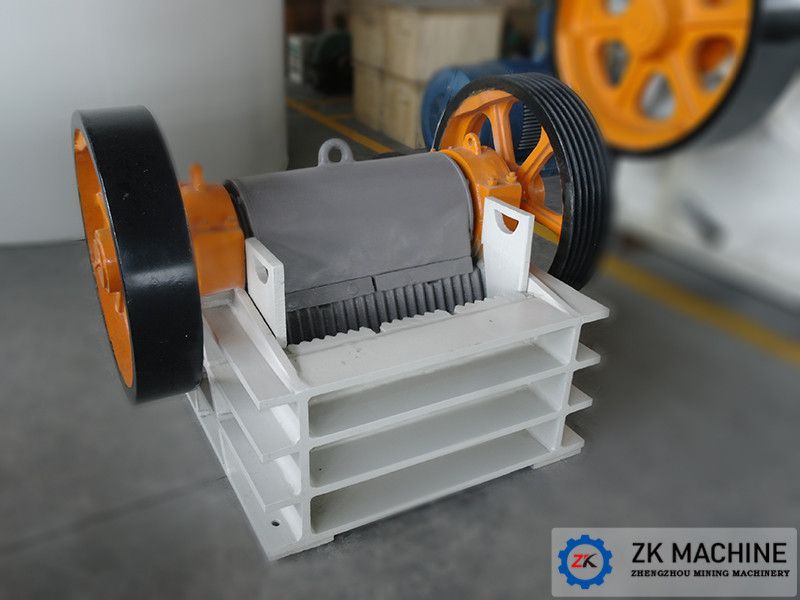Material of movable jaw crusher and fixed jaw plate
Date:2021-12-24 10:38:23
Author:admin
Views:
153
The upper part of the movable jaw plate of the jaw crusher is connected with the eccentric shaft, the lower part is supported by the thrust plate, and the fixed jaw plate is fixed on the frame. When the eccentric shaft rotates, the movable jaw plate mainly bears the squeezing action of the material, while the fixed jaw plate mainly bears the sliding cutting action of the material. As a part with high jaw wear rate, the choice of jaw plate material is related to the user's cost and benefit.
01 High Manganese Steel
High manganese steel is the traditional material of jaw plate of jaw crusher and has good impact load resistance. However, due to the structure of crusher, the opening angle between movable and fixed jaw plates is too large, which is easy to cause abrasive sliding. Due to insufficient deformation hardening, the surface hardness of jaw plate is low, abrasive short-range cutting and rapid wear of jaw plate. In order to improve the service life of the jaw plate, a variety of jaw plate materials have been developed, such as adding Cr, Mo, W, Ti, V, Nb and other elements to modify the high manganese steel, and dispersion strengthening the high manganese steel to improve its initial hardness and yield strength. In addition, medium manganese steel, low alloy steel, high chromium cast iron and high manganese steel composite have been developed, which have achieved good application results in production.
02 Medium Manganese Steel
Medium-manganese steel was first invented by Climax Molybdenum Company, and it was formally listed as a US patent in 1963. The hardening mechanism is: after the amount of manganese is reduced, the stability of austenite decreases. When subjected to impact or abrasion, the austenite is easily deformed to induce martensite transformation, which improves its wear resistance. The usual composition of medium manganese steel (%): 0.7-1.2C, 6-9Mn, 0.5-0.8Si, 1-2Cr and other trace elements V, Ti, Nb, rare earth, etc. The actual service life of medium manganese steel jaws can be increased by more than 20% compared with high manganese steel, and the cost is equivalent to that of high manganese steel.
03 High Chromium Cast Iron
Although high chromium cast iron has high wear resistance, but because of its poor toughness, the use of high chromium cast iron as the jaw plate does not necessarily achieve good results. In recent years, high-chromium cast iron has been used for inlay casting or bonding on the high-manganese steel jaw plate to form a composite jaw plate, which has a relative wear resistance of more than 3 times, which significantly increases the service life of the jaw plate. This is also an effective way to increase the service life of the jaw, but its manufacturing process is more complicated, so it is more difficult to manufacture.
04 Medium Carbon Low Alloy Cast Steel
Medium-carbon low-alloy cast steel is also a widely used wear-resistant material. Due to its high hardness (≥45HRC) and appropriate toughness (≥15J/cm²), it can resist the cutting and repeated extrusion of materials. The fatigue peeling, thus showing good abrasion resistance. At the same time, medium-carbon low-alloy cast steel can also be adjusted in composition and heat treatment process, so that the hardness and toughness can be changed in a large range to meet the requirements of different working conditions. The production operation test shows that the service life of general medium-carbon and low-alloy steel jaws can be increased by more than 3 times than that of high-manganese steel.
Recommendations for Jaw Plate Material Selection
In summary, the choice of jaw plate material should ideally meet the requirements of high hardness and high toughness, but the toughness and hardness of the material are often contradictory. Therefore, in the actual selection of materials, it is necessary to fully understand the working conditions and select the material reasonably.
1) Impact load is one of the important factors that should be considered in the reasonable selection of materials.
The larger the specification, the heavier the easily worn parts, the greater the fragmentation of the broken materials and the greater the impact load. At this time, the modified or dispersion strengthened high manganese steel can still be used as the object of material selection. For medium and small crushers, the impact load borne by the easily worn parts is not very large. It is difficult to fully work harden them by using high manganese steel. Under this working condition, good technical and economic benefits can be obtained by selecting medium carbon low alloy steel or high chromium cast iron / low alloy steel composite material.
2) The composition and hardness of materials are also factors that can not be ignored in rational material selection.
Generally speaking, the higher the hardness of the material, the higher the hardness requirements for the materials of easily worn parts. Therefore, under the condition of meeting the toughness requirements, the materials with high hardness should be selected as far as possible.
3) Reasonable material selection should also consider the wear mechanism of easily worn parts.
If it is mainly cutting wear, the hardness should be considered first when selecting materials; If plastic deformation wear or fatigue wear is the main wear, plasticity and toughness should be considered first in material selection.
Of course, when selecting materials, we should also consider its process rationality, which is easy to organize production and quality control.

